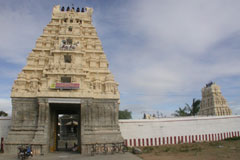Once, a king by the name "Kuban" lived and he was
against a Rishi named "Thutheesee". Thirumaal was along with Kuban
and as requested by him, Thirumaal threw the chakkram towards the Rishi to kill
him. But, the chakkram did not slice his body instead the edges of the
chakkaram got damaged. Thirumaal after realising his action, came to this
Sthalam and worshipped Shiva Perumaan. He used to perform poojas, for the
Perumaan by dedicating 1000 lotus flowers daily. Likewise, one day while doing
the pooja, he could find only 999 flowers. So, he finally plucks one of his
beautiful eyes and dedicated to Shiva Perumaan. After seeing this, Shiva
Perumaan came infront of Him, showed his presence and gave the chakkram towards
him. Since, Sri Hari (Thirumaal) got back his chakkram, this Sthalam is called
as "Hari Chakkrapuram" and since, thirumaal got peru (the
reason for which he worshipped the Perumaan is successful) it is called as
"Thirumaalperu (Thirumaal
+ Peru) ". Since thirumaal dedicated his Netram (eyes), he is called as
"Senthamarai Kannaperumal".
Gnana
sambhandhar in his Devara Pathigam explains the worship of Thirumaal and
Chandran while singing about this Sthalam.Another attraction of this temple is the beauty of
the utsavar Vishnu Perumaan. He is found in standing posture and has an eye on
one hand and lotus flower on the other hand.We can see Nandikeswarar in standing posture on the left
side in this Sthalam as we enter the temple. First opposite to the Moolavar,
Nandi is found and behind him, Thirumaal is found worshipping the Moolavar.
Here, theertham and Sadari are given after the Deepa Aradhanai slokam to Shiva
Perumaan.
10 days utsavams during Maasi month is the special
attraction of this Sthalam.
Sannadhis for Irattai pillaiyar (twin pillaiyars),
Chidambareswarar, Somaskandar, Subramanyar, Chandikeswarar, Natarajar, Gaja
Lakshmi, Pancha Maathars (Brahmi, Maheswari, Varahi, Vaishnavi and Durgai) are
found.
Swamy - Arulmighu Manikandeswarar as Swayambhu lingam facing east direction. He is
also called as "Arulmighu Maalvanangeeswar".
Ambal - Anjanatchi Amman facing south direction in a separate sannadhi.
She is also called as "Karunai Nayaki".
Theertham - Chakkra
theertham, Hari theertham.
Thala Viruksham - Vilvam
tree.
Pathigam - Thirunavukarasar,
Sambandar
The temple covers an area of 1.20 acre with compound walls.
This Sthalam is originally called as "Thiru
maarperu" (Thirumaalperu) and as the years passed, it is now called as
"Thirumaalpoor".
This Sthalam is also called as "Harichakkrapuram"
in Sanskrit.
Do:
- Do pray your Ishta Devata before pilgrimage to Temple.
- Do contact Temple Devasthanam information centre for enquiry, temple information and for Pooja details etc.
- Do reserve your travel and accommodation at Temple well in advance.
- Do bath and wear clean clothes before you enter the temple.
- Do concentrate on God and Goddess inside the temple.
- Do maintain silence and recite Om Namahsivaya or your Istamantram to yourself inside the temple.
- Do observe ancient custom and traditions while in Temple.
- Do respect religious sentiments at Temple.
- Do deposit your offerings in the hundi only.
Don't s:
- Do not come to Temple for any purpose other than worshipping of God and Goddess.
- Do not smoke at Temple.
- Do not consume alcoholic drinks at Temple.
- Do not eat non-vegetarian food in the Kshetram.
- Do not approach mediators for quick Darshanam. It may cause inconvenient to others.
- Do not carry any weapon inside the temple.
- Do not wear any head guards like helmets, caps, turbans and hats inside the temple premises.
- Do not perform Sastanga Pranama inside the Sanctum Sanctorum.
- Do not take much time while performing Sparsa Darshanam to God in Garbhagriha.
- Do not buy spurious prasadams from street vendors.
- Do not encourage beggars at Temple.
- Do not spit or create nuisance in the premises of the temple.
